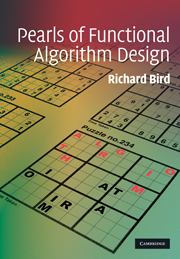Book contents
- Frontmatter
- Contents
- Preface
- 1 The smallest free number
- 2 A surpassing problem
- 3 Improving on saddleback search
- 4 A selection problem
- 5 Sorting pairwise sums
- 6 Making a century
- 7 Building a tree with minimum height
- 8 Unravelling greedy algorithms
- 9 Finding celebrities
- 10 Removing duplicates
- 11 Not the maximum segment sum
- 12 Ranking suffixes
- 13 The Burrows–Wheeler transform
- 14 The last tail
- 15 All the common prefixes
- 16 The Boyer–Moore algorithm
- 17 The Knuth–Morris–Pratt algorithm
- 18 Planning solves the Rush Hour problem
- 19 A simple Sudoku solver
- 20 The Countdown problem
- 21 Hylomorphisms and nexuses
- 22 Three ways of computing determinants
- 23 Inside the convex hull
- 24 Rational arithmetic coding
- 25 Integer arithmetic coding
- 26 The Schorr–Waite algorithm
- 27 Orderly insertion
- 28 Loopless functional algorithms
- 29 The Johnson–Trotter algorithm
- 30 Spider spinning for dummies
- Index
28 - Loopless functional algorithms
Published online by Cambridge University Press: 05 March 2013
- Frontmatter
- Contents
- Preface
- 1 The smallest free number
- 2 A surpassing problem
- 3 Improving on saddleback search
- 4 A selection problem
- 5 Sorting pairwise sums
- 6 Making a century
- 7 Building a tree with minimum height
- 8 Unravelling greedy algorithms
- 9 Finding celebrities
- 10 Removing duplicates
- 11 Not the maximum segment sum
- 12 Ranking suffixes
- 13 The Burrows–Wheeler transform
- 14 The last tail
- 15 All the common prefixes
- 16 The Boyer–Moore algorithm
- 17 The Knuth–Morris–Pratt algorithm
- 18 Planning solves the Rush Hour problem
- 19 A simple Sudoku solver
- 20 The Countdown problem
- 21 Hylomorphisms and nexuses
- 22 Three ways of computing determinants
- 23 Inside the convex hull
- 24 Rational arithmetic coding
- 25 Integer arithmetic coding
- 26 The Schorr–Waite algorithm
- 27 Orderly insertion
- 28 Loopless functional algorithms
- 29 The Johnson–Trotter algorithm
- 30 Spider spinning for dummies
- Index
Summary
Introduction
Imagine a program for generating combinatorial patterns of some kind, patterns such as the subsequences or permutations of a list. Suppose that each pattern is obtained from its predecessor by a single transition. For subsequences a transition i could mean “insert or delete the element at position i”. For permutations a transition i could mean “swap the item in position i with the one in position i − 1”. An algorithm for generating all patterns is called loopless if the first transition is produced in linear time and each subsequent transition in constant time. Note that it is the transitions that are produced in constant time, not the patterns; writing out a pattern is not usually possible in constant time.
Loopless algorithms were formulated in a procedural setting, and many clever tricks, such as the use of focus pointers, doubly linked lists and coroutines, have been used to construct them. This pearl and the following two explore what a purely functional approach can bring to the subject. We will calculate loopless functional versions of the Johnson–Trotter algorithm for producing permutations, the Koda–Ruskey algorithm for generating all prefixes of a forest and its generalisation to Knuth's spider spinning algorithm for generating all bit strings satisfying given inequality constraints. These novel functional algorithms rely on nothing more fancy than lists, trees and queues. The present pearl is mostly devoted to exploring the topic and giving some warm-up exercises.
- Type
- Chapter
- Information
- Pearls of Functional Algorithm Design , pp. 242 - 250Publisher: Cambridge University PressPrint publication year: 2010



